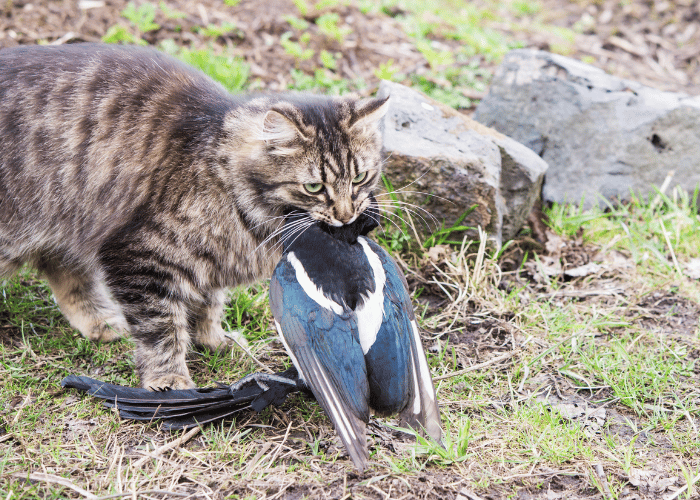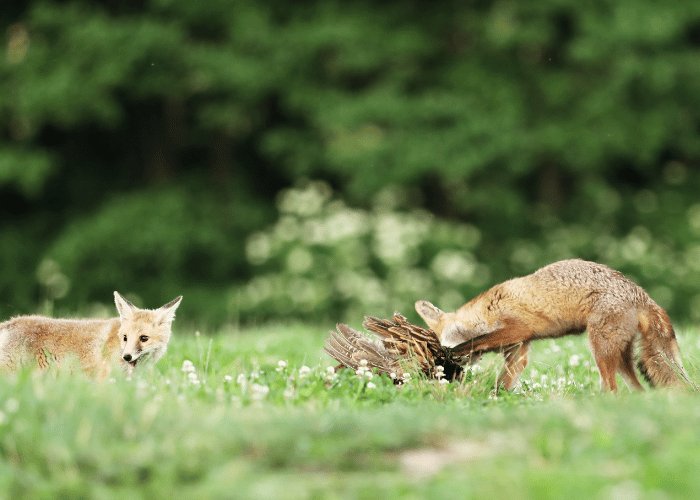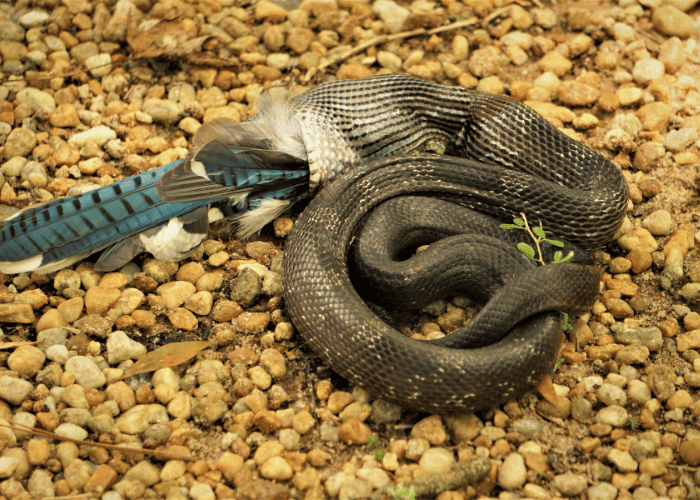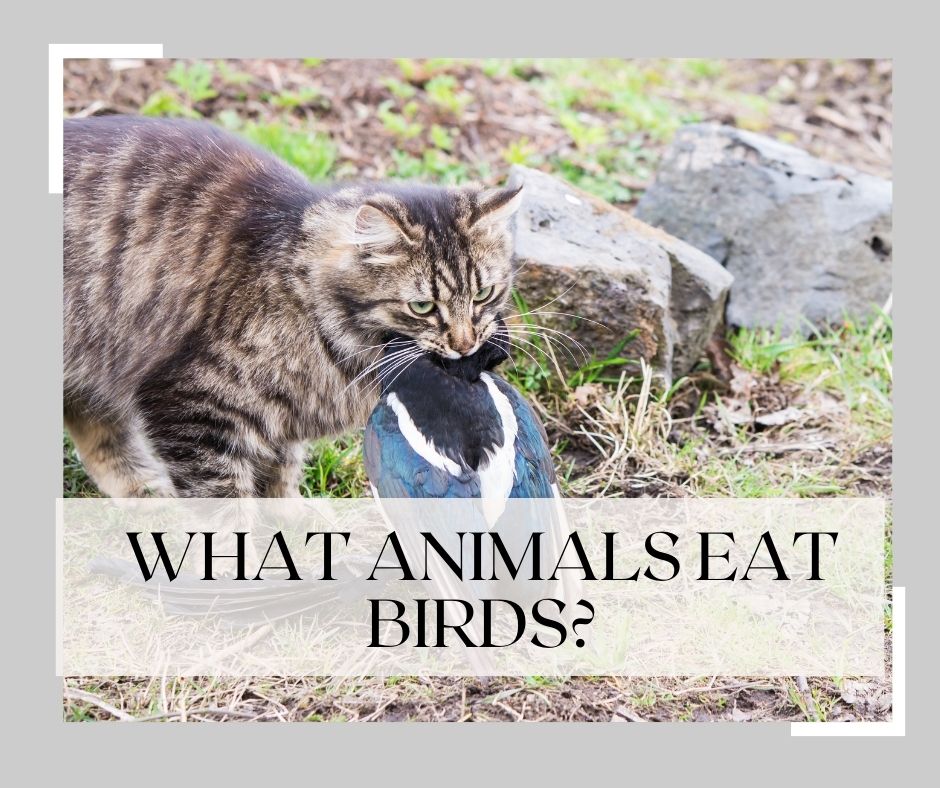What Animals Eat Birds
Table of Contents
If I told you that birds are on the menu for a surprising number of animals, would you believe me? It’s true! From sly foxes to stealthy snakes, the world is full of bird-eaters and it’s a fascinating tale of survival in the wild. Predation as it’s known, is a part of nature’s balance, and understanding it can give us a clearer picture of the complex cycle of life and death in the ecosystem.
There’s a lot of curiosity about who these feather-loving predators are, but they’re not always the usual suspects you’d think of. Major predators aren’t always big cats or sharp-toothed sharks. Sometimes they’re creatures in our own backyard! In some cases, even other birds eat birds! That’s right, the avian world isn’t all cute chirping and bird song. It can get pretty wild out there.
We’re going to dive deep into this topic today, looking at different creatures that count birds in their daily diet. It’s sure to be an eye-opener for all you wildlife enthusiasts out there. So, stay with me as we explore the savage, yet intriguing, ways of the natural world. This is nature at its rawest, after all, and there’s something truly fascinating about that!

Birds as a Part of the Food Chain
Imagine this: You’re watching a small, colorful bird sing melodiously in your backyard. The sight is peaceful, the setting idyllic. The bird’s life, however, is not all sunshine and seeds. Don’t be fooled by the serene scene, because for many in the animal kingdom, that lovely little bird could be dinner!
We often forget, but birds are a crucial part of the food chain. Their role doesn’t end at spreading seeds or controlling insects. Many larger animals count birds among their preferred meals.
Cats, both wild and domestic, are notoriously bird-hungry. It’s been estimated that cats in the U.S. alone kill billions of birds each year! Now, I’m not villainizing cats here—they’re just following their natural instincts.
Birds of prey, like owls, eagles, and hawks, are another major bird predator. Their sharp talons and even sharper eyesight make them formidable hunters. They zoom down from the sky, snatching up their feathered meals in a blink!
Then, there’s the snake—a bird’s slick and slithering nemesis. Ground-nesting birds especially have to watch out for these silent attackers. Now let’s not forget the raccoon, the crafty critter that will raid nests for bird eggs given the chance.
Still with me? Good, because we’re dipping our toes into aquatic territories now. Large fish and alligators add waterfowl and other birds to their underwater menus. Yes, even in the water, birds aren’t safe!
Whew! I think we covered quite a bit, don’t you? If this paragraph makes one thing clear, it’s this: to many animals, birds are conveniently sized packages of protein.
Stay tuned as we dive deeper into the intriguing world of nature, where the small become meals for the bigger, and life never ceases to amaze!
Common Bird Predators in the Animal Kingdom
Well, folks, I’ve got some news for you. The animal kingdom doesn’t always play nice. Case in point: there’s quite a lot of critters out there that seem to have a hankering for our feathered friends. Yup, you heard that right. There are different animals that eat birds. Now, let’s get stuck into who some of these bird-eating beasts might be.
Among the common avian predators, let’s start with the domestic cat (Felis catus). You might not want to think about it, but your little Mittens is a born hunter. In the US alone, it’s estimated that free-ranging domestic cats kill between 1.3 to 4.0 billion birds every year. That’s a lot of our feathery friends ending up as feline food!
Let’s get to our next avian adversary, Foxes. While they’re more known for raiding chicken coops, they’re not averse to snacking on wild birds either. They’ll often take advantage of nests left vulnerably on the ground or in low shrubs.
Switching gears a little, we’ve got to talk about the birds that eat other birds. This gets a bit freaky, but stick with me. Raptors like hawks and eagles are notorious bird-eaters, but even smaller species like the Shrike impale their feathered meals on thorns for easy snacking.
Don’t start me on snakes. They love a good egg or chick for breakfast. Certain snake species, like the rat snake, will climb trees to raid nests, quite literally robbing the cradle!
Here’s a rundown to make it clearer:
| Predator | How they hunt |
|---|---|
| Domestic Cat | Stalk and pounce |
| Fox | Scavenging and hunting |
| Hawk/Eagle | Dive and snatch |
| Snake | Tree-climbing and nest-raiding |
Just goes to show, it’s a wild world out there, even for the birds. Watch your feathered friends, folks, because there’s always something out there that might fancy them for dinner!

Understanding Mammalian Bird Predation
Birds soaring high in the sky, singing their sweet melodies – it’s a beautiful scene, isn’t it? Yet, beneath these harmonious scenes, there’s another, more somber reality to nature. Believe it or not, plenty of mammals have birds on their menu. Not the most cheery thought, I know, but it’s vital to understanding the circle of life.
First up in our list of voracious mealtime offenders is the domestic cat. Yep, your cute and cuddly furball is a serious predator to birds. It’s been estimated that cats in the US alone are responsible for the deaths of 1.3–4.0 billion birds annually. What a staggering number, right?
| Mammal | Estimated Birds Killed Annually (US Only) |
|---|---|
| Domestic Cat | 1.3–4.0 billion |
Secondly, we have foxes. They’re known to be crafty hunters, stealthily sneaking upon unaware birds and swooping in for the kill. Foxes usually target ground-nesting birds or young inexperienced fledglings.
Don’t let their size fool you, little stoats and weasels stand third on our list. These small mammals, with their slender bodies, slither their way into nests and make a quick meal out of eggs or young chicks.
Finally, here’s a shocker. Even though they’re not usually seen as predators, even some squirrels will snack on eggs or young chicks when they get a chance.
- Domestic Cats
- Foxes
- Stoats and Weasels
- Squirrels
So, there you go. While it’s a little tough to swallow (pun totally intended), this is the reality of nature. It’s a cycle, a food chain, and each creature plays their part. As they say, it’s a “dog eat dog” world out there, or, in our case, a “cat eat bird” one. Stay tuned for more eye-opening insights into the world of animals. I promise, they won’t all be this gritty.
The Role of Reptiles and Amphibians in Bird Consumption
You know, we often picture cats climbing trees and stealthily hunting birds, but there’s another group of animals with some bird-catching flair. It’s reptiles and amphibians! Bet you didn’t see that coming.
For instance, large reptiles like crocodiles and alligators have been known to snack on waterfowl when the opportunity arises. Sometimes, birds just make a wrong landing and snap, they’ve turned into an instant meal. It’s a tough world out there!
Did you know that smaller reptiles, like snakes, are often notorious bird-egg specialists? Yep, some species are known to slither their way up trees or into nests to have a little raw omelet. Their slender, flexible bodies allow them to reach places that other predators simply can’t. Here’s a little list of such expert egg-snatchers:
- Corn snakes
- Rat snakes
- King snakes
And guess what? It’s not just the egg-lovers—some snakes even specialise in hunting adult birds! The infamous boomslang and the twig snake of Africa just adore a good bird-feast.
Onto the amphibians. Now, they might not seem like your regular bird predators. But they, too, can prove lethal to birds, especially their young ones. For instance, ambitious bullfrogs have been observed catching and swallowing small birds whole. Bit of a surprise there, eh?
That’s not all. Ever heard of salamanders, those cute little critters that mostly keep to themselves under damp rocks or logs? Not so cute for baby birds, I’m afraid. Some larger species, like the tiger salamander, won’t hesitate to lunge at small, feathered morsels. The peaceful forest isn’t as peaceful as it seems!
But, you ask, why does this matter? Understanding the role of reptiles and amphibians in bird consumption gives insight into the dynamics of our natural world. It is part of the intricate web where every creature plays its role. So, the next time you see a snake up a tree or a frog by a pond, remember, they could just be out for their feathered lunch!

How Birds Factor into Aquatic Animal Diets
A lovely afternoon, folks! I’ve got to share some intriguing facts with y’all about how our aerial friends—the birds—factor into the diets of aquatic creatures. You’re probably thinking, “Wait, don’t birds usually eat fish?” Well, yes they do, but it’s also a two-way street. Some water-dwelling creatures have a taste for bird meat, too!
Let’s dive into specifics. You’ll be surprised to learn that large predatory fish like the tiger shark or the Northern Pike often feast on low-flying or waterfowl. Birds accidentally landing on water or entangled in surface vegetation, unfortunately, become irresistible prey for these underwater hunters.
But hey, don’t let’s let fish hog all the limelight. There are the aquatic reptiles, such as alligators and crocodiles, relishing a birdy treat. These reptiles are known to lurk about bird nesting areas, snatching any unlucky bird that happens to wander too close!
And let’s not forget about the semiaquatic mammals, like otters and minks. They’ve got an omnivore diet, meaning they eat both plants and other animals. Birds, specifically those nesting or resting near water bodies, unfortunately, aren’t off their menu.
Here’s a bit of a rundown for ya:
| Aquatic AnimalsLikelihood of Eating Birds | |
|---|---|
| Large Fish | High |
| Reptiles | Very High |
| Semiaquatic Mammals | Medium |
So next time you’re near a lake, river, or the beach, keep an eye out. You may just witness these miracles of nature in action. It’s a wild world out there! And always remember folks, Mother Nature isn’t just beautiful, she’s also surprisingly fierce. Now ain’t that a tweet! Well, I’ll see ya in the next section where we’ll delve into more of these fascinating food chains. Stay curious!
Wrapping Up: The Life Cycle and Predator Relationships of Birds
It’s been an incredible journey, hasn’t it? We’ve delved deep into the intricacies of birds’ lives, their predators, and even a few surprising facts along the way. Who could have guessed that such a diverse range of creatures, from sneaky cats to sly foxes, are fond of bird delicacies?
But it isn’t just about who eats whom. It’s also about understanding these interactions in the bigger picture of the life cycle and ecosystem balance. Remember, birds are not just prey but also predators. They control the populations of insects, rodents, and smaller birds. It’s a perpetual cycle of life that forms the core of our wonderful, wild world.
Our discussion wouldn’t be complete without shedding light on how these predator relationships change over the course of a bird’s life. Picture it, a vulnerable chick may fall prey to a variety of predators, while a fully grown, robust crow might swoop in fearlessly snatching a meal in the form of smaller rodents. Age and size can significantly impact these dynamics.
So here’s my takeaway for all you wonderful folks munching on this chunk of information; Nature is phenomenally balanced. Predator-prey interactions, as grim as they may seem, are instrumental in preserving this balance. Even in our backyards, the bird nibbling away on the bird-feeder and the cat stealthily stalking the bird, are all playing their part in this beautiful act we call life.
From me to you, keep deepening your understanding, keep asking questions, and keep exploring. Life is a mystery waiting to be unraveled, and every little creature, be it a bird, a cat or even a fox, has its unique role and story to tell. Until next time, birdwatchers, stay curious.






